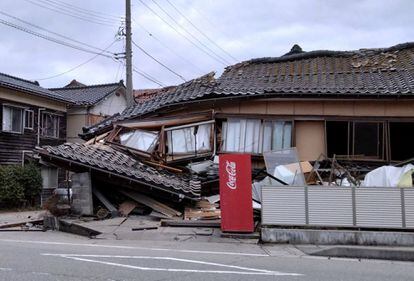A magnitude 7.6 earthquake shook central and western Japan this Monday, forcing a tsunami warning to be activated along much of the country's western coast, according to national broadcaster NHK. This is the largest tsunami warning issued by the Japanese meteorological agency since the 2011 disaster, which caused the Fukushima nuclear accident. This Monday's tremor initially hit the Noto peninsula, in Ishikawa prefecture, but the national agency Kyodo indicates that it has been felt from the northeastern prefecture of Aomori to the southwestern region of Kyushu. More than 51,000 people in five prefectures have been urged to evacuate their homes in anticipation of waves of up to five meters.
The Japanese Nuclear Regulatory Authority assures that no problems have been detected in the reactors at the Shika nuclear power plant in Ishikawa, and adds that there is no risk of radioactive leaks from the plants in the areas affected by the earthquake, as reported by NHK.
The tsunami warning urged people to quickly leave the coastal areas of Ishikawa, Niigata, Toyama and Yamagata prefectures. Waves of more than 1.2 meters reached the port of Wajima (Ishikawa) around 16:21 (08:21 Spanish peninsular time), according to NHK. The Hokuriku Electric Power nuclear plant (located in Toyama) has reported that more than 36,000 homes are experiencing power outages.
The Prime Minister, Fumio Kishida, has asked in a speech broadcast by the NHK network to “remain alert to the possibility of new earthquakes.” He has also urged residents of areas “where tsunamis are expected” to evacuate the area “as soon as possible.” Authorities are still assessing the extent of the damage.

Join EL PAÍS to follow all the news and read without limits.
Subscribe
The Ishikawa Prefectural Government and local emergency services have reported that many houses have collapsed and around 32,500 homes are experiencing power outages. Train services have been suspended in the region, while telecommunications operators Softbank and KDDI have communicated through their websites that interruptions are occurring in telephone and internet services in Ishikawa and Niigata. Blackouts are also affecting about 3,000 homes in Toyama Prefecture.
Russia also issues tsunami warning
In Russia, the Government has also issued a tsunami warning in the cities of Vladivostok and Kakhodka. The Ministry of Emergency Situations has reported that part of the western coast of the Russian island of Sakhalin (located north of Japan) is also at risk of a tsunami. The Russian news agency TASS has reported that the local population is being evacuated.
On March 11, 2011, a 9.1 magnitude earthquake caused a gigantic tsunami that devastated the north of the Japanese archipelago. The powerful tremor northeast of Tokyo, the largest since Japan began recording data more than 150 years ago, produced waves up to nine meters high that devastated the country's northeastern coast and damaged several nuclear reactors in the region, including the Fukushima Daiichi plant, which triggered a major accident from which the area has not yet recovered. That triple disaster cost the lives of nearly 20,000 people.
The Daiichi nuclear power plant, which is being decommissioned, began releasing its water into the ocean this summer, an initiative that, despite being backed by the International Atomic Energy Agency, has generated strong opposition among local residents and some countries. neighbors, especially China.
For its part, the Ministry of the Interior of South Korea has reported that the authorities of the province of Gangwon, on the east coast of the country, have sent alert messages urging the population to stay away from the coast. and to move towards shelters, given the possibility that the tsunami waves reach the region tonight.
Follow all the international information on Facebook and xor in our weekly newsletter.
Subscribe to continue reading
Read without limits
_
#Japan #activates #tsunami #warning #magnitude #earthquake